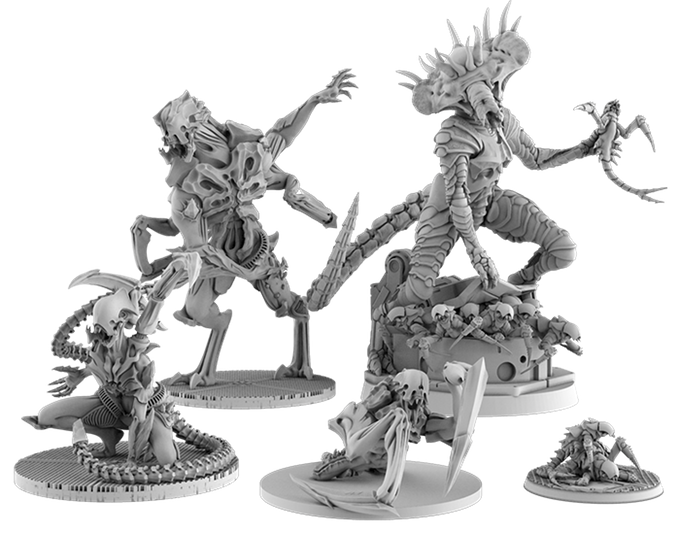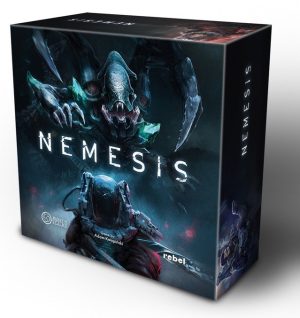
You’re roused early from cold sleep. The ship’s hibernatorium—and likely the remainder of the ship—is running on half power. There’s a body nearby. More accurately, there’s a body all over. For a moment, your sleep-fogged brain assumes somebody has splashed BBQ pork all over the floor and walls. Nope; that’s the crew member who was supposed to be on watch while everyone else slumbered.
Welcome to Nemesis, a board game with strong (but decidedly unofficial!) echoes of Ridley Scott’s Alien. It raised millions on Kickstarter—but is it any good?
At the table, everybody can hear you scream
Generally, board games don’t do horror very well.

Oh, they’re plenty good at tension. Setting up a climactic play over multiple turns, waiting to see if somebody undoes all your hard work by taking that card you’ve been eyeing, wondering whether your spouse is secretly Hitler... these are the moments board games create almost effortlessly. One time, I realized I’d been holding my breath during Exploding Kittens. Here was a game I wouldn’t ordinarily confess to playing, and yet my entire body was rigid was apprehension. (Granted, this was because I hoped the game would end as soon as possible, but still.)
Nemesis takes that tension and weaponizes it. From its very first moments, this is a game about the terror of the known, the half-known, and the unknown. Such is its dedication to that prickle you get when somebody threatens to jab you in the kidney that the game even features player elimination. Note that I’m saying Nemesis “features” player elimination, not that it suffers from it. Getting knocked out of a three-hour game within the first 40 minutes is a design decision, not an oversight. Sure, it’s a bummer. But don’t you think Executive Officer Kane was bummed when that chestburster did precisely what its name implies? I’ll bet he was totally bummed. I’ll bet he wishes he could have stuck around until the ending and helped Warrant Officer Ripley jettison that bastard alien out the airlock. I’ll bet he thinks it’s unfair that a single lapse of judgement resulted in having his sternum ruptured by an unknown lifeform. Too bad.
The same thing can happen in Nemesis, leaving a puddle of raspberry jelly and a freshly hatched creeper where once stood a human being. So it goes when you don’t head to the surgery room as soon as a space monster roots around your esophagus with its multi-jawed proboscis.
Of course, even this doesn’t come across as truly horrific. When your character makes too much noise and summons a queen from the depths of the ship’s utility level, you won’t kick your chair to the floor and leap from the table. Maybe you’ll swear. But scream? That’s a tall order.
Still, when it comes to tension, there’s plenty to go around here. And while you’re creeping through corridors to avoid drawing the attention of the game’s aliens, Nemesis is leveraging an even more potent agent—its players.
Fires, broken computers, and the cold hard vacuum of space
At first, the business of surviving feels pretty much as you’d expect. When you start, you don’t actually know the specific layout of the ship. The helm is located up front and the engines are back at the stubby end, but beyond that you can’t seem to recall whether the hibernatorium is adjacent to the cafeteria or the escape pods. Is this amnesia? Awakening sickness?
OK, it’s a little silly—even on a regular airline flight they take pains to point out the exits, and there you’re just sitting in a plain aluminum cylinder rather than a sprawling space vessel—but the gameplay in Nemesis actually benefits from this sense of dislocation. For the most part, your job is to uncover the ship, scrounge together the stuff you need to survive, and ensure you get home with all your bits attached. This usually entails checking the engines, fixing some stuff, maybe reentering the ship’s coordinates, and climbing back into hibernation. But because the ship’s layout is unknown, you’re feeling your way through the dark. Nothing is certain.
The obvious problem here is the aforementioned aliens, called “intruders,” and Nemesis smartly pitches them as unknowns. Successive plays see you growing more accustomed to the differences between creepers and adults, breeders and the dreaded queen, but the aliens’ aura of threat and mystery is never fully dispelled. For one thing, they lack firm details. You won’t find any stat cards or damage pips. Instead, their behaviors are dictated by card draw. Does an encounter with an adult intruder pose bodily harm, threat of contamination, or the possibility of a new hitchhiker in your stomach? In each case, the answer is “maybe.” Will a shotgun take apart an adult in one hit? Possibly, but also possibly not.
Even worse, the buggers appear at random from a draw bag as your exploration of the ship makes more of a ruckus. This gives every decision some bite, especially when you need to reach a room that’s hemmed in with noise tokens, you’re already hurt, and you suddenly remember just how many monstrosities have been added to the draw bag over the past hour. When your life is on the line—that is, your elimination from the game—do you really need to accomplish your objective?
-
One of the game's many characters.
-
Behold the sprawling ship!
-
An unpleasant confrontation.
-
You won’t know who to trust
Speaking of objectives, there are more subtle (but also more important) shakeups to the game. Much like in Dead of Winter, each character has their own goal card. Two, actually. At a certain point, each player is forced to choose one over the other; this decision comes after you’ve explored a portion of the ship, but not so early that the decision isn’t a bit of a gamble. Even tougher, you’re always given both a personal and a corporate objective. Maybe you want to burn the intruder hive or pilot the ship to Venus so the company can take the aliens into its possession. When the time comes to pick your goal, you often push for whatever seems most within reach
I’m not superstitious, but it almost goes without saying that objectives have a spooky way of flip-flopping in the middle of each play, with your long-discarded option suddenly seeming like a good idea compared to whatever you actually picked. Murder a fellow shipmate? What were you thinking?
That’s right—murder. Not directly, of course. But it’s possible to shut your companions behind doors, spark fires, draw intruder attention to a nearby shipmate, or vent somebody into the vacuum of outer space. This is the true source of paranoia in Nemesis. The unknown is all around, but the real terror is the unknown right beside you. There’s no guarantee anybody at the table will behave in such a manner. But in Nemesis, there’s no guarantee they won’t. That somebody isn’t an android or a company stooge. That they aren’t nursing a hidden grudge or a desire to leave everybody behind while they board an escape pod. Without trust, where are we? Trapped in a burning shower room with an alien who’s got limbs like switchblades, that’s where.
True, Nemesis has the occasional catching edge. That’s deliberate. Rather than elegant, the game is evocative. Don’t let the piles of plastic fool you—this is one of the most carefully arranged storytelling games of the past year.
Listing image by Awaken Realms
reader comments
30